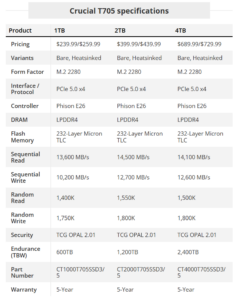Situatie
The Crucial T705 SSD is a powerhouse in the world of PCIe 5.0 storage, aimed at enthusiasts and power users looking for top-tier speed and efficiency. This drive pushes boundaries with its blazing read and write speeds of 14.5 GB/s and 12.7 GB/s, respectively, thanks to the Phison E26 controller and Micron’s advanced 232-layer TLC NAND technology.
Random read and write IOPS also impress, standing at 1.55M and 1.8M, making it ideal for demanding applications like gaming, video editing, or high-speed data transfer.
Solutie
Includes a DRAM cache, an essential feature for maintaining consistent high-speed performance. The endurance rating is equally commendable, with 1,200 TBW ensuring years of reliable use for typical workloads.
However, the T705 isn’t for everyone. It requires a PCIe 5.0-compatible motherboard to unlock its full potential, and it’s best paired with a heatsink (or purchased in the heatsink-equipped version) to mitigate the heat generated during heavy workloads. Without a compatible setup, you might not see its full benefits. For console users or older systems, this drive might be overkill.
SPECS LIST:
Another excellent option is the MSI MEG X670E ACE, optimized for AMD Ryzen processors. With its “Lightning Gen 5” M.2 slot, it ensures stable performance for Gen 5 SSDs. It’s equipped with extensive cooling solutions and supports DDR5 RAM, making it an excellent pairing for the Crucial T705 if you’re using an AMD-based setup. The board’s high-end design ensures smooth operation under heavy workloads, like gaming, video editing, or AI applications.
Both boards provide excellent thermal solutions, critical for maintaining the T705’s performance, especially under sustained loads. While they may seem like overkill for casual users, they are ideal for anyone seeking cutting-edge performance.
After using the Crucial T705 SSD 2TB for two months, I can confidently say it’s an exceptional performer. The insane read speeds of up to 14.5 GB/s and write speeds of 12.7 GB/s have drastically improved file transfer times and system responsiveness. For gaming, applications load near-instantly, and video editing workflows are seamless.
That said, for most everyday users, this SSD is likely overkill. Its full potential only shines with a PCIe 5.0-compatible motherboard, which not everyone has. If you’re not dealing with high-performance workloads or transferring massive files regularly, a PCIe 4.0 drive offers more than enough speed at a better price point.


Leave A Comment?